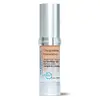Too Faced Born This Way Undetectable Medium-To-Full Coverage Foundation Versus Oxygenetix Oxygenating Foundation
What's inside
What's inside
 Key Ingredients
Key Ingredients

 Benefits
Benefits

 Concerns
Concerns

 Ingredients Side-by-side
Ingredients Side-by-side

Water
Skin ConditioningDimethicone
EmollientCoco-Caprylate/Caprate
EmollientTrimethylsiloxysilicate
EmollientPhenyl Trimethicone
Skin ConditioningCetyl PEG/PPG-10/1 Dimethicone
EmulsifyingPropanediol
SolventPolyglyceryl-4 Isostearate
EmulsifyingGlycerin
HumectantMica
Cosmetic ColorantSodium Hyaluronate
HumectantRhododendron Ferrugineum Extract
MaskingCocos Nucifera Fruit Juice
EmollientTocopheryl Acetate
AntioxidantCaprylyl Glycol
EmollientMethicone
EmollientCocos Nucifera Oil
MaskingDisteardimonium Hectorite
StabilisingSodium Chloride
Masking1,2-Hexanediol
Skin ConditioningTrisodium Ethylenediamine Disuccinate
Sodium Dehydroacetate
PreservativeSodium Benzoate
MaskingPotassium Sorbate
PreservativeCI 77891
Cosmetic ColorantCI 77491
Cosmetic ColorantCI 77492
Cosmetic ColorantCI 77499
Cosmetic ColorantWater, Dimethicone, Coco-Caprylate/Caprate, Trimethylsiloxysilicate, Phenyl Trimethicone, Cetyl PEG/PPG-10/1 Dimethicone, Propanediol, Polyglyceryl-4 Isostearate, Glycerin, Mica, Sodium Hyaluronate, Rhododendron Ferrugineum Extract, Cocos Nucifera Fruit Juice, Tocopheryl Acetate, Caprylyl Glycol, Methicone, Cocos Nucifera Oil, Disteardimonium Hectorite, Sodium Chloride, 1,2-Hexanediol, Trisodium Ethylenediamine Disuccinate, Sodium Dehydroacetate, Sodium Benzoate, Potassium Sorbate, CI 77891, CI 77491, CI 77492, CI 77499
Aloe Barbadensis Sprout
HumectantIsododecane
EmollientTitanium Dioxide
Cosmetic ColorantMethicone
EmollientPolyglyceryl-4 Isostearate
EmulsifyingCetyl Dimethicone
EmollientHexyl Laurate
EmollientCyclopentasiloxane
EmollientPEG/PPG-20/15 Dimethicone
EmulsifyingSaccharomyces Cerevisiae Extract
Skin ConditioningPEG-8
HumectantDioctyldodecyl Dodecanedioate
EmollientIron Oxides
Vitis Vinifera Seed Extract
AntimicrobialGlycerin
HumectantO-Cymen-5-Ol
AntimicrobialSilica
AbrasiveCyclomethicone
EmollientDisteardimonium Hectorite
StabilisingPropylene Carbonate
SolventMaris Sal
Skin ConditioningDimethicone/Vinyl Dimethicone Crosspolymer
Skin ConditioningAloe Barbadensis Sprout, Isododecane, Titanium Dioxide, Methicone, Polyglyceryl-4 Isostearate, Cetyl Dimethicone, Hexyl Laurate, Cyclopentasiloxane, PEG/PPG-20/15 Dimethicone, Saccharomyces Cerevisiae Extract, PEG-8, Dioctyldodecyl Dodecanedioate, Iron Oxides, Vitis Vinifera Seed Extract, Glycerin, O-Cymen-5-Ol, Silica, Cyclomethicone, Disteardimonium Hectorite, Propylene Carbonate, Maris Sal, Dimethicone/Vinyl Dimethicone Crosspolymer
 Reviews
Reviews

Ingredients Explained
These ingredients are found in both products.
Ingredients higher up in an ingredient list are typically present in a larger amount.
Disteardimonium Hectorite comes from the clay mineral named hectorite. It is used to add thickness to a product.
It can also help stabilize a product by helping to disperse other ingredients.
Hectorite is a rare, white clay mineral.
Learn more about Disteardimonium HectoriteGlycerin is already naturally found in your skin. It helps moisturize and protect your skin.
A study from 2016 found glycerin to be more effective as a humectant than AHAs and hyaluronic acid.
As a humectant, it helps the skin stay hydrated by pulling moisture to your skin. The low molecular weight of glycerin allows it to pull moisture into the deeper layers of your skin.
Hydrated skin improves your skin barrier; Your skin barrier helps protect against irritants and bacteria.
Glycerin has also been found to have antimicrobial and antiviral properties. Due to these properties, glycerin is often used in wound and burn treatments.
In cosmetics, glycerin is usually derived from plants such as soybean or palm. However, it can also be sourced from animals, such as tallow or animal fat.
This ingredient is organic, colorless, odorless, and non-toxic.
Glycerin is the name for this ingredient in American English. British English uses Glycerol/Glycerine.
Learn more about GlycerinMethicone is a type of silicone and is a simpler form of dimethicone.
Silicones are used to enhance the texture of products and have emollient properties. Methicone is used to give products a silky texture and improves spreadability.
This ingredient is an emulsifer and stabilizer. It comes from isostearic acid and polyglycerin.
As an emulsifier, it helps blend oil and water to improve texture, spreadbility, and application.
Due to it being derived from isostearic acid, this ingredient may not be fungal acne safe.
Learn more about Polyglyceryl-4 Isostearate